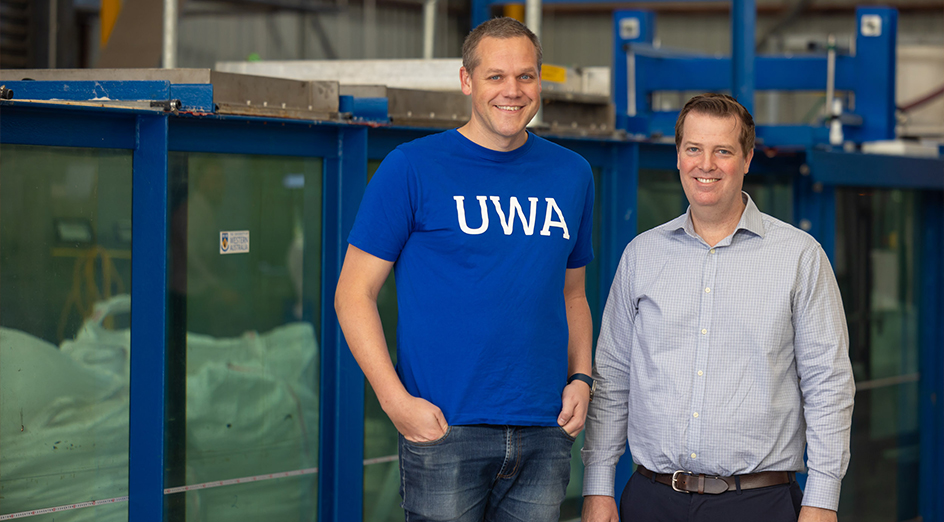Written by Carrie Cox
A unique UWA research laboratory that can simulate conditions in oceanic and coastal environments with precision has industry knocking on its door for solutions to new questions arising out of the blue economy.
The Coastal and Offshore Research Lab (CORL), which occupies an area the size of a footy pitch in Shenton Park, is the only facility of its type in Australia that can simultaneously support both coastal and offshore engineering research from the surface to the seabed and from deep to shallow water.
Since the addition of an Olympic-pool-length wave flume in 2021, CORL has become a go-to facility for innovators and organisations wanting evidence-based data and guidelines to support the design of bespoke projects and major blue economy initiatives.
“Our research with diverse marine industries has been growing significantly in recent years due to Australia’s dependency on the ocean and the need to advance innovative approaches to address societal challenges,” says UWA Professor Ryan Lowe, whose expertise is focused on developing novel engineering solutions to protect coastlines and infrastructure from coastal hazards.
 Image: Associate Professor Scott Draper and Professor Ryan Lowe.
Image: Associate Professor Scott Draper and Professor Ryan Lowe.
“Since 2021, the lab has enabled almost 100 research projects – about 30 a year – across the areas of renewable energy, offshore technology, coastal infrastructure design and coastal protection projects. Industry is coming to us with very specific questions and wanting very specific solutions.”
Professor Lowe’s research colleague UWA Associate Professor Scott Draper, an expert in solving fluid mechanics problems relevant to ocean energy applications, says the lab has brought together disparate fields of knowledge in a way that wasn’t previously possible.
“UWA has always done strong offshore research and also strong coastal research, but this lab has brought them together and enabled a lot more collaborative work, both within UWA and with collaborators across the state,” Associate Professor Draper says.
“The lab itself is critical because these marine environments are incredibly complicated and you can’t just numerically model them; you need to conduct physical experiments to understand the physics involved.”
Game-changing research infrastructure in one location
Key components of the UWA Coastal and Offshore Engineering Lab include:
Large O-tube: This 24-metre circular flume through which water is rapidly circulated simulates underwater wave and current conditions close to the seabed. It is being used to revolutionise research on sediment transport, to design subsea structures and to assess the stability of pipelines and power cables connected to wind turbines and other offshore infrastructure.
Wave Flume: The unique construction of this 54-metre flume uses two types of wave-generation paddles in order to accurately simulate both coastal and offshore wave environments.
Coastal protection initiatives
Roughly half of the lab’s core activity today is focused on supporting new approaches for coastal protection, with a particular focus on the use of more environmentally friendly, nature-based alternatives to conventional structures such as seawalls and breakwaters.
“For example, one of our current projects is looking at whether the co-location of large kelp farms can remove wave energy and therefore potentially protect inshore coastal infrastructure from storm hazards,” explains Professor Lowe.
“And we’re also working with US Defence to look at the design of natural, self-sustaining reef structures that can grow over time and protect critical defence and civilian infrastructure located on coastlines.
“With climate change accelerating sea level rises and increasing the severity of storms, coastal populations and critical infrastructure are increasingly at risk worldwide. One goal of our research is to reduce uncertainty about the effectiveness of new nature-based alternatives to traditional grey infrastructure and to promote greater uptake by coastal engineers and planners.”
Renewable energy projects
Start-ups and organisations in the renewable energy sector are increasingly looking to CORL to conduct experiments that complement field measurements and inform future decision-making.
While WA is yet to host a floating wind turbine at sea, the state’s R&D is powering many of them located around the world.
“A lot of academics and industry here in WA are already engaged in global offshore wind projects,” says Associate Professor Draper, “so as a state we’re already leading the world in this area even though we don’t yet have turbines here.
“Through geotechnics, cable design, hydrodynamics and other key areas, WA is having a big impact on the design of global windfarms, partly because of the knowledge base already built up through oil and gas and partly because of new research being led by UWA.
“It’s great to see the University providing industry with new and relevant research, while at the same time industry is providing us with new questions – it’s a nice circle.”
